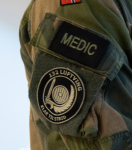2. When you say thin hulled, is it only with Russian subs or do all the coastal subs have thinner hulls? And if its only Russian, why would that be?
Russia makes small special missions submarines, some have treads like a tank and crawl on the sea floor, others host special forces, all are rather small but some can dive well over 200 meters.
This is a British Tramrod model used for underwater mining. Russia has similar ones for inserting special forces, cable tapping and other undersea activities. Tracks from such craft have been found in Norwegian and Swedish waters, including recently.

As for coastal submarines, they're all designed to patrol shallow waters so their hulls, across all nations, are thin and light. Double hulled submarines are largely only used by Russia.
1. Do ocean going submarines need to be nuclear powered?
Not at all. Historically DE powered submarines could cover distances of upwards of 15000 km. The German Type IX could stay on station for days, if not weeks. They plagued Atlantic convoys for years during WWII.
India's DE powered Kilo class submarines have an at-sea duration of between 40-50 days depending on their stores.
Modern AIP designs are able to maintain an at sea duration of upwards of 12 weeks at a time on strictly without needing to refuel or rearm - 3 months endurance. They're limited by their smaller size though, making endurance the main reason why nuclear powered boats are preferred for at sea patrols. That's by design. They tend to be smaller as AIP designs lose range as they gain speed where as nuclear boats do not. AIP endurance maximized when the boat is at rest. For instance a Type 214 can travel 2300km at 4 knots, but when the speed is increased by double to 8 knots range endurance drops to a paltry 400km. A nuclear boat of the same size would have a range limited by food supplies and a speed limited by hull design.

An American Virginia class submarine needs to have its reactor serviced once per the life of the boat and take on new provisions once every six months. Large nuclear boats need to be maintained less and have more room for critical supplies. Nuclear power can be used to generate clean drinking water.
There's no reason the same could be done with an AIP design though. It'd be more complex and need to be larger to accommodate for an increase in submarine size, most AIP designs are rather small compared to nuclear boats, but it's definitely doable. Still as speed increases endurance would drop. That's the inherent problem with AIP design until more efficient batteries come online that can store and distribute power more efficiently.
Russian submarines tend to have a crew about half of what western submarines do because they automate much of the submarine's processes, partly due to a lack of training and partly due to cost, but the result is high theoretical endurance outside of maintenance periods (though they have historically spent less time at sea owing to a lack of qualified submariners, unlike the American Gold Crew, Blue Crew concept).
A Russian Yasen class submarine has a crew compliment of 65 sailors. An American Virginia has 135. This results, theoretically, into greater endurance as the crew can be supplied with more food and stores, given the extra space and lower requirement for daily usage among the crew.
It doesn't always work out that way. Training, crew competence, maintenance and logistical support all play an equal amount when it comes to submarine endurance.
On the flip side the American NR-1, the world's smallest nuclear submarine, could stay at sea for a maximum of 330 days, but 16 was more realistic for a full crew. The size and handling made it notorious for making its crew sick.
3. In an UASV would it not make sense for them to just 'bottom out' and passively monitor their surrounding, activating when they have a hostile contact and not giving any response time? This could be a potential scenario. Of course, this would need a databank pre loaded in to the UASV.
That concept is already in use with CAPTOR-type mines which are a torpedo - essentially an ROV in their own right - being housed in a capsule moored the sea floor. When something passes overhead that's registered as hostile the torpedo is released and homes in on the target. This is an American MK60 CAPTOR. They house a MK46 torpedo
China and Russia use rocket-assisted variants. This is a Chinese EM52 fast-rising rocket mine. It's unguided, but works on the same principle.
I don't see why the concept couldn't be used with an ROV. ROVs are basically more intelligent torpedoes.






 ? Now I have 2 UXOs I need to dispose of.
? Now I have 2 UXOs I need to dispose of.
















 . 2019 my butt. That footage is at least 6 years old
. 2019 my butt. That footage is at least 6 years old !
! .
.

























 . I'm not squeamish. I've seen blood, a lot of blood, but for some reason drawing blood makes me shiver
. I'm not squeamish. I've seen blood, a lot of blood, but for some reason drawing blood makes me shiver .
.


















